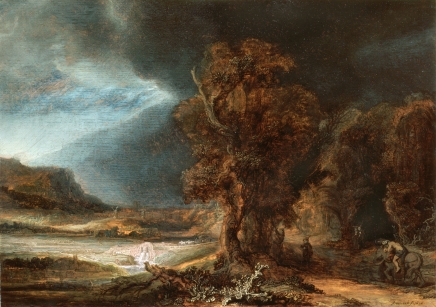MNK The Wyspiański
pl. Sikorskiego 6, 31-115 Kraków- Monday: closed
- Tuesday: 10.00-17.00
- Wednesday - Thursday: closed
- Friday - Sunday: 10.00-17.00
Information and reservations on weekdays 9 a.m.- 4 p.m.
The Director of the National Museum in Krakow
Deputy Director for Programme Activity
Deputy Director for Strategy and Communications
Deputy director for the Management
Chief Accountant
Chief Cataloguer of the National Museum in Krakow
Chief Conservator

Exhibition of painting "Landscape with the Good Samaritan" of the great Dutch artist Rembrandt Harmenszoon van Rijn (1606–1669).
"Landscape with the Good Samaritan" of 1638 is one of few known, preserved, single oil landscapes by Rembrandt van Rijn, as well as one of the most valuable works of European art in Polish collections. Artist reached to Christ's parable described in the Gospel of Luke (10;30-36):
A certain man was going down from Jerusalem to Jericho, and he fell among robbers, who both stripped him
and beat him, and departed, leaving him half dead. By chance a certain priest was going down that way. When he saw him, he passed by on the other side. In the same way a Levite also, when he came to the place, and saw him, passed by on the other side. But a certain Samaritan, as he travelled, came where he was. When he saw him, he was moved with compassion, came to him, and bound up his wounds, pouring on oil and wine. He set him on his own animal, and brought him to an inn, and took care of him.
In the foreground on the right, on the road by the edge of the forest, we can see the good Samaritan, placing a wounded half-naked man on a horse. They are being watched by a scared woman and man, embracing each other, who probably had witnessed the attack. The group of solid oaks in the foreground, below which we can see a hunter and a boy hunting birds, divides the painting into two parts. On the left, there is a sun-lit vast plain, closed with remote hills with an oriental town and Dutch windmills on the walls (most likely the Biblical Jericho). At the turn of the road behind the waterfall, we can identify two small figures of the priest and Levite, as well as the rich man's carriage with four white horses, that indifferently passed the man in need.
However, the main theme of the painting is not the landscape, but rather love and mercy between fellow men. Rembrandt not only showed a Biblical episode against the background of the landscape, but he also closely connected it to this landscape, and the changes in nature reflect what is going on in the human world. Wind disperses dark stormy clouds, showing blue sky. Storm and darkness, symbols of evil, disappear, and the plain is lit by the first rays of the sun, symbolizing the good. It is similar with the human world - indifference and insensibility to the other person were overcome by a merciful act of the good Samaritan. The painting features both Biblical elements (the figures of the priest and Levite, oriental town, palm at the edge of the forest), as well as the elements of Dutch 17th-century reality (windmills on the town walls, the carriage). In this way, the artist emphasized the durability of the Biblical message about love and mercy, whose role was stressed by Christ's preaching and which constitutes the nature of humanity until today.
Landscape with the Good Samaritan is a great Baroque painting, where the dramatic character of the situation is emphasized by strong contrasts of light and shadow, and whose texture is also rich and diverse.
The painting was bought in Paris by a French painter Jan Piotr Norblin in 1774 and brought by him to Poland, where the artist had come at the invitation of the Czartoryski family. Around 1813 it got to their collection at the Gothic House in Puławy.
